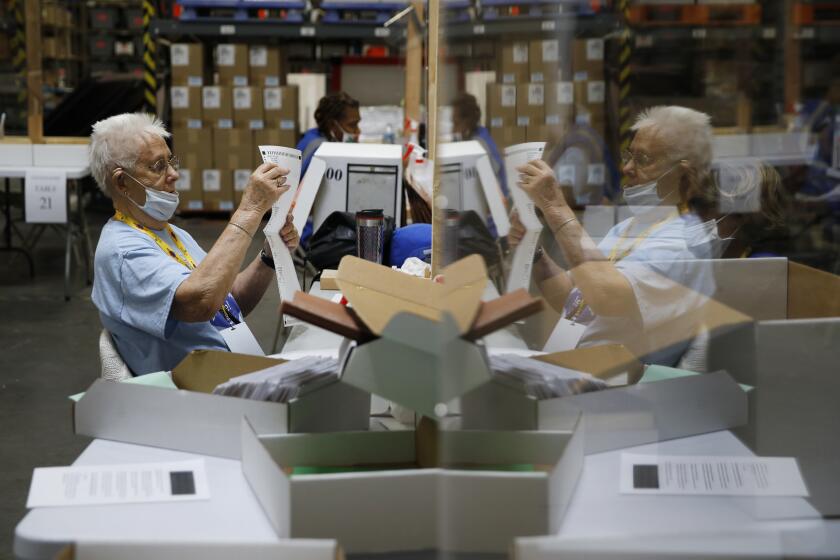Groups Fueling Ad Blitz for LNG
- Share via
SACRAMENTO — An influential business coalition has hired Gov. Arnold Schwarzenegger’s favorite political consultant to mount a $1-million public relations blitz touting the benefits of liquefied natural gas.
The pro-LNG offensive being planned by consultant Mike Murphy has the earmarks of a campaign for public office, relying on advertising, polling, focus groups and other tools of the political trade. Murphy’s new bosses, which include energy companies and some of the state’s richest and most savvy special interest lobbying groups, want him to redefine the debate over LNG, a controversial form of natural gas.
For the record:
12:00 a.m. Dec. 16, 2004 For The Record
Los Angeles Times Thursday December 16, 2004 Home Edition Main News Part A Page 2 National Desk 1 inches; 56 words Type of Material: Correction
Liquefied natural gas project -- A chart with an article about liquefied natural gas in Monday’s Business section indicated that Royal Dutch/Shell was a partner with Sempra Energy in the proposed Energia Costa Azul project in Baja California, Mexico. Shell has committed to buying output from the facility but does not have a stake in it.
“We’re going to need more natural gas in the state in the coming decade to fuel our economy,” said Joseph Lyons, an energy lobbyist with the California Manufacturers and Technology Assn., one of the leaders of the Californians for Clean Affordable and Safe Energy coalition. “We’re not going to be able to conserve our way out of a gas crisis.”
Developers are vying for financing and permits to build as many as half a dozen coastal terminals in California and northern Mexico to unload the LNG. The gas, produced in such distant countries as Australia, Indonesia and Russia, is supercooled until it turns to liquid so it can be shipped across the ocean in special tankers.
Industry and government officials contend that importing large volumes of LNG would diversify California’s sources of natural gas, which is burned to generate most of the state’s electricity.
Without a steady flow of LNG, the state could be whipsawed by the kind of volatile prices that boosted electricity and natural gas bills during the energy crisis of 2000 and 2001, LNG advocates say.
But LNG projects have ignited considerable opposition.
LNG critics -- mainly environmentalists, alternative energy advocates and coastal residents -- say the state should work to become less dependent on fossil fuels. They worry about accidents or terrorist attacks, and those fears have generated headlines and stirred up environmental activists and homeowners along the Pacific coast.
Now, industry is getting ready to fight back, led by the California manufacturers and technology coalition and the California Chamber of Commerce.
What’s needed to win the LNG war is an industry-sponsored campaign that “will provide political air cover to elected officials of both parties who might be willing to support LNG but fear fallout [from voters] in their districts,” according to Murphy’s winning sales pitch, which was presented to the state manufacturers group in August.
The pro-LNG coalition includes the California League of Food Processors, California Retailers Assn., California Building Industry Assn., Western States Petroleum Assn., Agricultural Council of California, Silicon Valley Manufacturing Group and the American Electronics Assn. It also has the backing of energy companies vying for a foothold in the potentially lucrative California LNG market: Sempra Energy, Royal Dutch/Shell Group, ChevronTexaco Corp., Mitsubishi Corp., BHP Billiton and Woodside Petroleum Ltd.
The trade groups and energy corporations have contributed tens of millions of dollars to the political campaigns of Schwarzenegger and lawmakers in recent years.
Industry leaders said they picked Murphy and his firm, Navigators, because of the thoroughness of their plan to unleash an “air and ground war” in the media, the statehouse and community forums up and down the state. The campaign’s goal is to convince people that LNG is “important to the economy ... safe ... and good for the environment.”
Energy lobbyist Lyons of the state manufacturers association said his group was particularly impressed with Murphy’s record of helping Schwarzenegger oust then-Gov. Gray Davis in the 2003 recall election.
Navigators further burnished its reputation by running Schwarzenegger’s subsequent ballot efforts to refinance the state debt with $15 billion in bonds and to defeat initiatives by Indian tribes and race tracks to expand casino gambling.
In between Schwarzenegger’s campaigns, Navigators, which opened a Sacramento office in the shadow of the state Capitol late last year, has nurtured a private-sector practice. Last summer, it managed a drive by Calpine Corp. and other non-utility electricity generators to kill a bill backed by Southern California Edison Co.
The proposal, AB 2006 by Assembly Speaker Fabian Nunez (D-Los Angeles), would have partially re-regulated California’s power market. It passed the Democratic-controlled Legislature but was vetoed in September by Schwarzenegger.
“We interviewed a lot of firms and chose the team that could do the best job,” Lyons said. “We knew they could hit the ground running on this energy stuff.”
Lyons, however, stressed that Murphy’s close relationship with Schwarzenegger was “not a factor” in his hiring. Todd Harris, the head of Navigators’ Sacramento office, said he makes it clear to prospective clients that “if you’re looking for someone to lobby the administration, you should look for someone else.”
Harris and Joe Desmond, the governor’s top energy advisor, said they maintain an arms-length relationship to avoid potential conflicts of interest. Nevertheless, Navigators wasn’t shy about plastering Schwarzenegger’s picture on all 27 pages of its LNG PowerPoint sales pitch.
The presentation started out by noting that Schwarzenegger “is generally supportive of LNG” and quoted a statement in his campaign platform promising to “explore building facilities for safely importing liquefied natural gas.”
The campaign, which is still being organized, is designed to use advertising on television and in print media in addition to speakers and public events to “put cross pressure on liberal and environmental groups as well as other groups in opposition by organizing targeted local coalitions in favor of LNG,” according to Navigators’ pitch.
Advertising needs to “change the face of LNG for the public,” Navigators’ presentation said. People need to be convinced that LNG is not just about big energy companies but, rather, “local, state and national labor leaders, minority activists, environmentalists, small business owners.”
Part of the $1-million war chest also could be spent on polling and focus groups, conducting campaign-style “opposition research,” holding educational symposiums and paying academics to do studies on the benefits of LNG, Navigators said.
Environmentalists, who operate with volunteers on tiny budgets, said they considered it a compliment to their organizing skills that industry felt it needed to run a million-dollar campaign against them.
“Clearly, they are responding to citizen opposition. They’re trying to counter how most Californians feel about clean energy,” said Rory Cox of environmental protection group Pacific Environment in San Francisco.
Clean-air activists said they weren’t about to support importing LNG until they saw evidence that demand for more energy couldn’t be met by greater energy efficiency and use of renewable sources like wind and solar power. They noted that the California Energy Commission was projecting growth in demand for LNG at only 1% a year over the next decade.
LNG skeptics have asked the California Public Utilities Commission to hold hearings on whether the state needs LNG.
Meanwhile, industry is trying to create phony pro-LNG public support, said Michael Shames, director of the San Diego-based Utility Consumers’ Action Network. Shames thinks the Schwarzenegger administration is along for the ride, despite official denials.
“They want to provide the governor cover for what he’s already privately indicated he’s going to do,” Shames said. “They’re building a factual case out of thin air.”
*
(BEGIN TEXT OF INFOBOX)
LNG plans
Oil firms are proceeding with plans for liquefied natural gas facilities off the Ventura coast, in the Port of Long Beach and in Baja California, from which natural gas may be piped to the United States. No location has been announced for a sixth project, planned by ChevronTexaco.
Proposed projects
1. Off Oxnard
Company: Crystal Energy/Small Ventures
Average capacity: 800 million cubic feet per day
Type of facility: Existing platform, Grace, with new subsea pipeline, to receive and regasify LNG for Southland use
2. Off Malibu
Company: BHP Billiton
Average capacity: 700 million cubic feet per day
Type of facility: Permanently moored facility with new subsea pipeline to receive and regasify LNG for Southland use
3. Port of Long Beach
Company: Sound Energy Solutions/Mitsubishi
Average capacity: 700 million cubic feet per day
Type of facility: Berth, new 2.3-mile pipeline and facility to store and regasify LNG and load trucks for Southland use.
4. Puerto Coronado (off Tijuana)
Company: ChevronTexaco
Average capacity: 700 million cubic feet per day
Type of facility: Offshore import facility would regasify LNG and send it through a new pipeline to Baja California and U.S.
5. Energia Costa Azul
Company: Sempra Energy/Shell
Average capacity: 1 billion cubic feet per day
Type of facility: Port infrastructure and receiving facility to regasify LNG for use in Baja California and U.S.
Sources: California Energy Commission and Federal Energy Regulatory Commission Graphics reporting by Cheryl Brownstein-Santiago
More to Read
Sign up for Essential California
The most important California stories and recommendations in your inbox every morning.
You may occasionally receive promotional content from the Los Angeles Times.














